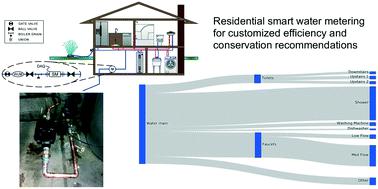当前位置:
X-MOL 学术
›
Environ. Sci.: Water Res. Technol.
›
论文详情
Our official English website, www.x-mol.net, welcomes your feedback! (Note: you will need to create a separate account there.)
Emerging investigator series: disaggregating residential sector high-resolution smart water meter data into appliance end-uses with unsupervised machine learning
Environmental Science: Water Research & Technology ( IF 5 ) Pub Date : 2021-2-5 , DOI: 10.1039/d0ew00724b Gabrielle M. Bethke 1, 2, 3 , Abigail R. Cohen 1, 2, 3 , Ashlynn S. Stillwell 1, 2, 3
Environmental Science: Water Research & Technology ( IF 5 ) Pub Date : 2021-2-5 , DOI: 10.1039/d0ew00724b Gabrielle M. Bethke 1, 2, 3 , Abigail R. Cohen 1, 2, 3 , Ashlynn S. Stillwell 1, 2, 3
Affiliation

|
The residential sector accounts for a significant amount of water consumption in the United States. Understanding this water consumption behavior provides an opportunity for water savings, which are important for sustaining freshwater resources. In this study, we analyzed 1-second resolution smart water meter data from a 4-person household over one year as a demonstration. We disaggregated the data using derivative signals of the influent water flow rate at the water supply point of the home to identify start and end times of water events. k-means clustering, an unsupervised machine learning method, then categorized these water events based on information collected from the appliance/fixture end uses. The use of unsupervised learning reduces the training data requirements and lowers the barrier of implementation for the model. Using the water use profiles, we determined peak demand times and identified seasonal, weekly, and daily trends. These results provide insight into specific water conservation and efficiency opportunities within the household (e.g., reduced shower durations), including the reduction of water consumption during peak demand hours. The widespread implementation of this type of smart water metering and disaggregation system could improve water conservation and efficiency on a larger scale and reduce stress on local infrastructure systems and water resources.
中文翻译:

新兴的研究人员系列:通过无监督的机器学习将住宅部门的高分辨率智能水表数据分解为设备最终用途
在美国,住宅部门消耗了大量的水。了解这种用水行为为节水提供了机会,这对于维持淡水资源很重要。在本研究中,我们分析了一个4人家庭一年多来的1秒分辨率智能水表数据,作为演示。我们使用家庭供水点进水流量的导数信号分解数据,以识别水事件的开始和结束时间。ķ-均值聚类(一种无监督的机器学习方法),然后根据从设备/固定设备最终用途收集的信息对这些水事件进行分类。无监督学习的使用减少了训练数据的需求,并降低了模型实施的障碍。利用用水情况,我们确定了高峰需求时间,并确定了季节性,每周和每日趋势。这些结果提供了对家庭内特定节水和增效机会的洞察力(例如,减少淋浴时间),包括减少高峰时段的用水量。这种类型的智能水计量和分解系统的广泛实施可以在更大范围内提高节水效率,并减轻当地基础设施系统和水资源的压力。
更新日期:2021-02-12
中文翻译:

新兴的研究人员系列:通过无监督的机器学习将住宅部门的高分辨率智能水表数据分解为设备最终用途
在美国,住宅部门消耗了大量的水。了解这种用水行为为节水提供了机会,这对于维持淡水资源很重要。在本研究中,我们分析了一个4人家庭一年多来的1秒分辨率智能水表数据,作为演示。我们使用家庭供水点进水流量的导数信号分解数据,以识别水事件的开始和结束时间。ķ-均值聚类(一种无监督的机器学习方法),然后根据从设备/固定设备最终用途收集的信息对这些水事件进行分类。无监督学习的使用减少了训练数据的需求,并降低了模型实施的障碍。利用用水情况,我们确定了高峰需求时间,并确定了季节性,每周和每日趋势。这些结果提供了对家庭内特定节水和增效机会的洞察力(例如,减少淋浴时间),包括减少高峰时段的用水量。这种类型的智能水计量和分解系统的广泛实施可以在更大范围内提高节水效率,并减轻当地基础设施系统和水资源的压力。


























 京公网安备 11010802027423号
京公网安备 11010802027423号